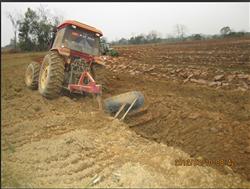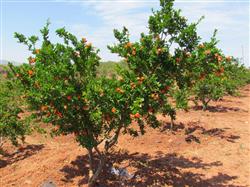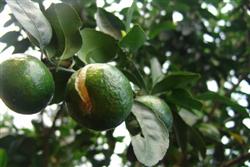Video pictures of banana planting technology

Banana likes high temperature and high humidity. The growth temperature is usually 20: 35 ℃, and the optimum temperature is 24: 32 ℃. The critical temperature of each organ is 10: 12 ℃ in leaf, 13 ℃ in fruit and 13-15 ℃ in root. The annual average temperature above 21 ℃ is the main distribution area of banana, and a few are distributed in the areas below 20 ℃. Banana plant has high water content, large leaf area and large transpiration, so it needs a lot of water. Banana monthly average moisture to 200mm 300 mm is the most suitable, at least not less than 50 mm. Bananas require plenty of sunshine, but not too violently. Detailed banana planting techniques can be referred to the following methods: banana garden soil preparation: banana garden is mainly divided into paddy field banana garden and dryland banana garden. The paddy banana garden includes the old enclosed countryside of the delta, the new enclosed garden of the tidal flat, and the alluvial garden of the river. The enclosed farmland is located in the middle and lower reaches of the river or along the coast, and attention should be paid to building high dams to prevent tides and floods from rushing into the park. Generally speaking, the groundwater level of the paddy field is higher, so it is necessary to raise the border and deep ditch to lower the water level. Two-stage drainage and irrigation were used in garden plots with less than 20 hours, with peripheral ditches (perimeter ditches) and border ditches, and three-stage drainage and irrigation in gardens with dry 20 hours, with border ditches, middle drainage ditches and total drainage ditches. The width of the banana garden border is 4. 67-6. 0m, the width of the furrow is 50~100cm, the depth is 50-100cm, the width of the middle or periphery ditch is 100-150cm, the depth is 100-130cm, the total ditch width is 300-500cm, the depth is 150-200cm. The general tillage layer of the old enclosed field is shallow and the organic matter is low, so more organic fertilizer should be applied; the salt content of the new enclosed field is higher, so pay attention to washing saline-alkali before sandalwood irrigation or planting lotus root, sugarcane and other salt-tolerant crops for several years. two。 Dry land banana garden includes platform garden, slope garden and mountain garden. The key to opening the garden is to do a good job of soil and water conservation, the Qiong trench method is adopted when the slope is less than 10 degrees, and horizontal terraces are built when the slope is more than 10 degrees. In dryland orchards with irrigation conditions, a small drainage irrigation ditch (20-30cm and 15-25cm) should be set up for every 4-8 rows of plantains, and dryland gardens with difficult irrigation should be trenched or ridged between rows, or trees 10-20cm below the ground should be repaired to intercept Rain Water. It is necessary to do a good job of deep ploughing and increasing the application of organic manure (farm manure and green manure) in dry land where the soil is thin and easy to consolidate. 2-4 months before planting, the garden should be turned deep 1-2 times at a depth of 25-40cm to fully weathered the soil, crushed soil and leveled the border 10-30 days before planting. Banana seedling selection: the selection of excellent varieties is one of the keys to high quality, high yield and high benefit of banana production. Therefore, varieties with high quality and high yield, strong adaptability and strong wind resistance must be selected. After planting practice in recent years, the better varieties are Guangdong banana No. 2, Brazil No. 3 and so on. Banana is propagated asexually, and the seedlings are bud-absorbing seedlings and tissue culture seedlings. There are three kinds of ① sucking buds (sucking buds in front of the Beginning of Winter, scaly sword leaves, some scale leaves withered after winter, hence the name), red bamboo shoots (sucking buds after warm spring, leaf sheath red, hence the name) and flying across the mountain (sucking buds from the old banana head after harvest, also known as water buds). The tissue culture plantlets of ② grew neatly, and it was suitable to be planted with 6-10 leaves in leaf age. Tissue culture seedlings are easy to produce variation, weak growth and poor stress resistance, so they should be carefully managed at the initial stage of growth. Banana planting: (1) preparation before planting. The selected working procedures of banana orchard are as follows: banana garden with large slope of ①, digging holes after repairing the platform, hole specifications of 60cm × 60cm × 50cm, ② flat sloping land, paddy field banana plantation, deep ploughing and raking → broken soil, → excavating drainage ditch → border planning, → digging holes, applying base fertilizer → to prepare for planting. (2) planting specifications. About 160 plants are planted per mu, and the specification is 200~220cm × 200cm. (3) planting method. Generally, it is planted in a rectangle with two rows, and it is appropriate to plant in a single row in a banana garden with poor drainage. Planting method: put the nutrition bag seedlings into the hole, cover part of the soil, cut twice on the plastic bag with a sharp knife, pull out the film bag, then cover the soil on the adobe with 3cm, and sprinkle the fixed root water. Planting should be carried out on cloudy and rainy days. (4) planting period. It takes about 10 to 12 months from planting to harvest. The selection of planting period is the main measure to adjust the yield period (the factors related to the production period are: planting period, fertilizer and water management varieties and market demand). Banana fertilization: according to research, Xiangya banana needs 150.5 grams of nitrogen, 40.7grams of phosphorus and 561grams of potassium per plant per year. But the plant can only absorb part of the fertilizer, of which nitrogen accounts for 50% of the amount of fertilizer applied, potassium accounts for 50% of the amount of fertilizer applied, and phosphorus accounts for only 20% to 30% of the amount of fertilizer applied, that is to say, 50% of the nitrogen, phosphorus and potassium fertilizers applied are lost or fixed by the soil. Therefore, the amount of fertilizer application should include the total amount of absorption and loss or fixation of the plant. In order to determine the reasonable amount of fertilizer applied to the garden, we must also consider the local climatic conditions. Therefore, banana fertilization should be quantified according to the land situation, and we can refer to the following methods for fertilization. 1, the general application of organic fertilizer in winter and spring, can be about 50 cm from the banana head to open 20-30 cm deep ditches and holes, ditch application or hole application. From relying on the mother plant to supply nutrients, to absorbing nutrients from the soil. The plant growth is not large in this period. 2. Seedling stage: it lasted 2-3 months from absorbing bud germination to large leaves, mainly increasing leaf area, forming corms and roots, from relying on mother plants to absorbing nutrients from soil, and the plant growth was small in this period. 3. Vegetative growth period: it lasted about 5-6 months from the beginning of large leaves to flower bud differentiation, which was the vegetative growth period of banana, which rapidly increased the number of leaves and leaf area and accumulated a large amount of nutrients to lay the foundation for flower bud differentiation. The plant bioaccumulation in this period accounts for about 10% and 16% of the biological yield in the whole growth period. 4. The bud stage: from flower bud differentiation to bud emergence, it lasts about 3-4 months. Petiole thickening, leaf spacing thickening, pseudostem (banana body) hypertrophy, the masses known as "pregnancy". At this stage, the differentiation of female flowers was completed, and the male flowers began to differentiate, and the flowers and young fruits developed at the same time. Finally, the growth of new leaves entered the final stage and the leaf area decreased. The plant biological yield in this period accounts for 30% to 35% of the biological yield in the whole breeding period. According to the investigation, the tall banana buds when it pulls out 31 leaves, and the dwarf banana buds when it pulls 28 leaves. 5. The period of fruit development and maturity: the differentiation of male and female flowers is completed to the maturity of the fruit. During this period, the fruit expanded rapidly, the nutrients in the plant transferred to the fruit, the lower leaves withered and yellowed quickly, the growth weakened and aging gradually. After the fruit is harvested, the aboveground parts are generally cut off, and the sucking buds produced by the underground stem of the mother plant continue the offspring and begin a new growth cycle. 6. medium and trace elements water and fertilizer: during the growing period, banana trees can be supplemented with various trace elements such as calcium, magnesium, sulfur, boron, zinc and iron by means of water and fertilizer. Banana pest control: banana bunchy top disease: commonly known as "banana male", is a virus. Infected plants generally can not bud, mainly through seedlings and banana aphids. Prevention and control methods: (1) sucking buds is easy to carry disease, so it is not suitable to introduce varieties in disease areas and popularize the planting of test-tube plantlets. (2) to eliminate the transmission vector, 2000 times solution of aphid thistle (or 10 grams of aphid lice) + 15 ml of mycotoxin (or virus K) + 25 g of plant physiological balancing agent + Yunda120 + 15 kg of water were sprayed once every 5-7 days for 2 consecutive 3 times. at the same time, the diseased plants were irrigated twice with plant physiological balancing agent (once every 5 days). Kill aphids and control viruses. (3) diseased plants were found, and two days after killing aphids, they were dug up and lime was sprinkled on the disease hole. Mosaic heart rot: this disease is a viral disease. After the occurrence, it can be seen that the leaf sheath collapses and decays, and the heart leaves die. The prevention and control method is the same as the bundle top disease. Leaf spot disease: from July to October, the climate is high temperature and high humidity, typhoons are frequent, it is easy to occur this disease. Control methods: (1) strengthen cultivation management and improve plant disease resistance; (2) keep banana garden clean, cut off diseased leaves and burn; (3) spray: ① 20ml + plant physiological balance agent 25g + gamma harvest 10ml + Yunda 120 + water 15kg every 2 months ② 25% enemy EC 10ml + phylloxanthum 1 + plant physiological balance agent 25g + water 15kg or control with chlorothalonil and pyrethrum. Fusarium wilt: fungal disease, alias Panama disease and yellow leaf disease, that destroyed large banana plantations in America. There are 4 physiological races of pathogens. Attention should be paid to quarantine and blockade of disease areas in ①, removal of diseased plants and planting of resistant varieties in ②, rotation of flood and drought after digging up diseased plants in seriously diseased areas, and cultivation of disease-free tissue culture seedlings in ③. Scab: fungal disease. Bananas are common before harvest and do less harm to ripe fruit. There are many small spots scattered on the green fruit, which loses its commercial value. Although the harmfulness is not serious, it affects the appearance and causes the occurrence of carbon gangrene. Prevention and control can be carried out in the banana bud after the implementation of isolation protection bag to prevent disease, often remove the disease residue. Chemical control with 75% chlorpromazine 600-8OO doubling solution. . Weevil: mainly harms the pseudostem of banana. For the banana garden with poor cleaning effect, the withered leaves and residual stems should be removed in time, the old banana head should be dug up, burned or buried deeply, and the breeding place should be eliminated. Pay attention to check the banana plant, found that the pseudostem has glial outflow, you can use Nongdile 1000 times liquid or kung fu 2000 times liquid spray or spray irrigation pseudostem. Sprinkle Milol or Di Xing granules on banana head or banana plate, cover the soil, or place 3g Milol or Di Xing at the bifurcations of 3 old leaf sheaths of pseudostem, once every 20 days, 2 times for 3 times. Cross-vein aphids, net bugs: mainly absorb leaf juice. Should master when the first occurrence, with 1.5% pule 1500 times or 2.5% kungfu 3000 times liquid and other pesticides spray. Spray twice every 10 days. Butterfly, Spodoptera litura: mainly harms leaves. Check the banana plant frequently, remove the insect bud or burn the egg block in time. When the newly hatched larvae gathered at the edge of the leaf or the back of the leaf, the larvae were sprayed with 1.5% pule 1500-fold solution or 10% efficient 2000-fold solution. Leaf mite: it mainly harms the leaves and absorbs juice. the injured leaves are grayish white and die when they are serious. Pay attention to the inspection, when it is found that there is mite harm in the veins on the back of the leaf, it can be sprayed with acaricides such as 1000-fold triclofenac or 1000-fold Tetra-mite or 1500-fold acaricide. The medicine should be used alternately, once every 7 to 10 days, and sprayed for 2 or 3 times. Banana management: banana head cultivating soil: it can not only prevent the underground stem of banana plant from exposing to the ground, but also play the role of fertilization and irrigation. Banana irrigation: sufficient water supply in the early stage of banana development, to ensure an adequate water supply, in addition to keeping the soil moist, but also to store 2/3 of the water in the border ditch. In the middle and later stages of fruit development, it is necessary to keep the soil moist. If the weather is dry and the soil is cracked, it should be drenched in time, every 2-3 days, 50kg per plant, 3-5 times, otherwise, the leaves will curl and wilt due to lack of water, affecting the expansion and ripening of banana fruit. School buds: banana buds must be checked to see if they are blocked by petioles or leaves and cannot hang down. move the buds to the right or right of petioles or leaves in time to let them droop naturally. Bud breaking and fruit thinning: the bud can be broken when the bud blooms to 1: 2 comb male flower. If you want to combine the fruit thinning, you can break the bud when the female flower opens early. When the female flower is 9: 10, the female flower is removed, the tail is removed at 11: 12, the tail is removed at 13: 14, and the tail is 4 at more than 15 sulfur. The final thinned tail comb should retain a fruit finger. Bud breaking and fruit thinning should be carried out in the afternoon on a sunny day. Management after bud breaking: after bud breaking, spray the fruit with 500 times aldicarb or 800 times chlorothalonil and 400 times banana Zengguoling, then cover the ear with a blue film bag, and separate the bag from the ear with Kraft paper or clean banana leaves to prevent the fruit from burning. The above measures can prevent the fruit from infecting scab, keep the fruit surface clean and beautiful, promote fruit early ripening, increase the length of fruit finger and increase the yield of banana. Click to get more banana planting techniques click to get more fruit planting techniques
- Prev

Pomegranate tree planting: how to cut pomegranate in winter?
How do ordinary pomegranates be cut in winter? Do you have a netizen who can introduce me to the method of pomegranate tree in order to ensure the yield of the coming year, it is necessary to carry out winter cutting in winter, the method can refer to the following operation. First, cultivate pomegranate tree shape: pomegranate because its trunk is not obvious, when planting in the courtyard, in order to prevent livestock and poultry danger.
- Next

Planting technique of sugar orange: how to prevent cracking of sugar orange?
How to prevent cracking of sugar tangerine? Is there any good way to prevent sugar orange from cracking? Please introduce the prevention and control methods of sugar orange cracking fruit can refer to the following list: 1, apply less phosphate fertilizer, increase potassium, fertilizer and farm manure, and dig a hole of 30ml and 40cm deep on both sides of the canopy of the fruit tree from late July to early August.
Related
- Moge, come on! The staff of the peasant association in the producing area of cantaloupe were frightened when the crowd gathered.
- Causes and Solutions of low Fruit setting rate of Apple
- Symptoms and control measures of passion fruit virus disease
- Fruit growing lesson: how do apple orchards keep high yields?
- Can you build orchards in the mountains? What are the pros and cons?
- How to manage the coloring period of Crisson grape?
- This paper introduces the processing technology of two kinds of fig products.
- How much is a month for retired teachers in rural areas by 2020?
- How can strawberry planting increase sugar content? We should pay attention to management in many aspects.
- What are the cultivation techniques on how to improve the yield of golden fruit?

